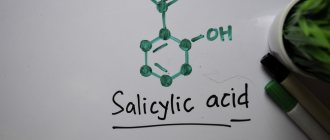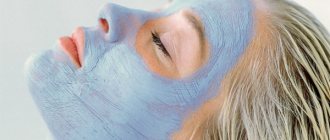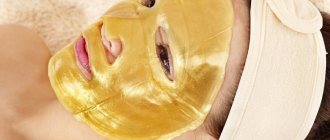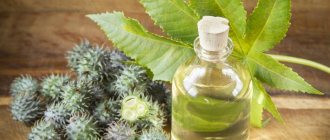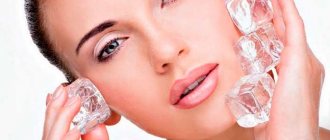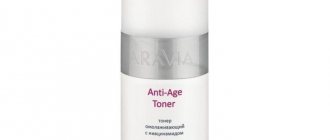Home » Face
Category: Face
There are a few key players in acne and acne treatments that you should be aware of, and salicylic acid is at the top of that list. Simply put, salicylic acid is one of acne's biggest enemies. But, what exactly does salicylic acid do, and what are the best ways to reap its benefits? To find out, we consulted dermatologists to help figure out exactly how salicylic acid works on the skin, who should (and shouldn't) use it, and why it's such a popular choice for preventing acne.
- What is salicylic acid?
- The benefits and harms of salicylic acid for the face
- How to properly use salicylic acid on the face
- The use of salicylic acid for different types of facial skin
- How to use salicylic acid on the face
- The best salicylic acid creams for the face
- The best salicylic acid face masks
- The best lotions and toners with salicylic acid for the face
- The best peelings with salicylic acid for the face
What is salicylic acid?
First of all, let's establish what salicylic acid is. It's a little complicated, but the exact structure of salicylic acid is important in explaining why (and how) it works so well. When it comes to skin care products, there are two classes of acids that you'll often see: beta hydroxy acids (BHAs) and alpha hydroxy acids (AHAs).
“Salicylic acid is a beta hydroxy acid. This means that the hydroxyl part of the molecule is separated from the acid part by two carbon atoms, unlike Alpha Hydroxyl Acid where they are separated by one carbon atom.
Additionally, salicylic acid is actually derived from willow bark and it belongs to a class of ingredients called salicylates. This structure is important because it makes salicylic acid more oil soluble so it can penetrate into skin pores.
Both alpha and beta hydroxy acids exfoliate skin, but AHAs are water soluble while BHAs are oil soluble. Examples of AHAs, for reference, include glycolic acid and lactic acid.
In general, oil-soluble ingredients penetrate the lipid layers between skin cells more easily. Oil-soluble ingredients can penetrate the skin at a deeper level than their water-soluble counterparts.
AHAs work well on the surface of the skin to loosen old, dead skin and reveal new, fresh skin. Salicylic acid works deeper and is able to penetrate into pores to unclog them.
IMPORTANT! Salicylic lotion is not recommended for use if:
- individual intolerance to one or more components of the acne lotion;
- active phase of dermatitis of any origin;
- allergic skin reactions to vaccinations and medications;
- exacerbation of herpetic infection;
- deep damage to the epidermis (burns, wounds);
- high skin sensitivity.
To make the use of medicinal cosmetics more convenient, PROPELLER produces salicylic acne lotion for different skin types.
The benefits and harms of salicylic acid for the face
Prevention of comedones
Comedones are usually the precursor to acne. They appear as small bumps that contain debris, sebum and (sometimes) bacteria inside the enlarged hair follicle. As comedones develop, they can either remain open (blackheads) or closed (whiteheads). When these clogged pores continue to fill beneath the skin's surface, pus, inflammation, infection, or even cell rupture can occur. Using salicylic acid not only treats existing blackheads, but can also prevent the formation of comedones by penetrating deep into the pores and loosening the particles within them.
Salicylic acid penetrates deep into the skin of the face
All this means is that salicylic acid can penetrate deep into your skin to do its job. It's this quality that makes salicylic acid such a powerful acne-fighting ingredient—especially blackheads and whiteheads.
Once it penetrates the skin, salicylic acid “dissolves skin debris that clogs pores, acts as an anti-inflammatory, and also helps clear up red, inflamed pimples and pustules faster.
This ingredient can penetrate so deep into the skin that it actually breaks down the bonds between skin cells. Once it has penetrated the skin, the acidic part of the molecule can dissolve some of the intracellular “glue” that holds skin cells together.
Anti-inflammatory properties of salicylic acid
Salicylic acid contains the same anti-inflammatory ingredients as aspirin, which explains why some (wrongly!) suggest making face masks with a numbing agent. Don't: Aspirin was not formulated for the skin and may irritate your skin, but salicylic acid is formulated for the skin. It can reduce swollen, red and inflamed pores due to its soothing effect, resulting in a more balanced skin tone. Those who have post-inflammatory hyperpigmentation can use the anti-inflammatory properties of salicylic acid to correct sun spots, age spots, and inflammatory acne.
Salicylic acid exfoliates skin
This breakdown of skin cells also promotes exfoliation. Salicylic acid is considered a keratolytic, meaning it is ideal for superior exfoliation. Keratolytic drugs cause softening and exfoliation of the top layer of skin cells.
Salicylic acid also loosens and breaks down desmosomes (the attachments between cells in the outer layer of skin). This desmolytic action stimulates skin exfoliation and unclogs pores.
One idea behind the etiology of acne is that skin cells don't behave normally, and instead of being sloughed off through the healthy skin cell cycle, they stick together and clog pores, creating cysts and blackheads. Salicylic acid helps in removing and weakening these skin cells and helps dissolve blackheads.”
Salicylic acid helps with acne and acne
There are three factors that contribute to acne: abnormal shedding of skin cells, excess oil, and bacteria. Salicylic acid helps with the first cause by dissolving skin debris that clogs pores and causes acne.
Salicylic acid can directly dissolve keratin plugs and regulate skin cells. It does have some effectiveness against cystic acne due to its antibacterial activity, but less than classic blackheads and whiteheads.
Harm of salicylic acid
The main negative side effect of salicylic acid is its ability to irritate and dry out the skin in those who are very sensitive or overuse it.
Depending on the concentration and number of uses, some people may experience dryness, flaking, redness and some skin irritation. For this reason, those with already severely dry or sensitive skin should avoid SA completely. It is also not a good choice if you are pregnant or taking certain medications, including blood thinners.
What's more serious: “Applying salicylic acid or any salicylate to very large parts of your body can result in salicylate poisoning. So just don't apply a layer all over your body—stick to acne-prone areas only.
Indications and contraindications for the use of salicylic lotion
Alcohol-free acne lotion is especially effective on teenage skin, but can also be used at an older age.
Indications for use:
- excessively oily facial skin;
- comedones and pimples;
- uneven facial skin texture due to pimples, enlarged and inflamed pores;
- manifestations of acne and its consequences (scars, scars);
- small scratches (due to scratching), cosmetic defects of shallow penetration.
How to properly use salicylic acid on the face
If you are using acids for the first time, your skin may feel a slight tingling sensation, but over time it will become accustomed to salicylic acid and its benefits.
Remember that if you use exfoliating acids in the morning, you should always keep an eye on the SPF.
You will likely see results in four to six weeks after which you should continue to use it for long-term effects. This means you shouldn't expect any miracles overnight—good skin requires patience. If you want to see the effects of salicylic acid, use it for at least a month until you start thinking about next steps.
How is salicylic acid used in a cosmetologist's office?
Salicylic peeling has a keratolytic effect through protein denaturation. It has antiseptic and anti-inflammatory effects. The high level of lipophilicity ensures the penetration of the active substance into the deep layers of the skin, which explains the comedolytic effect of the procedure.
The cosmetologist uses 10% acid for superficial peeling, 15-20% for superficial-medium peeling and 30% for medium peeling. It is not worth experimenting with such concentrations at home157.
The use of salicylic acid for different types of facial skin
If you are interested in using salicylic acid to treat acne, consider the current condition of your skin. While some skin types are ready to benefit greatly from this acne-fighting product, others need to be a little more careful with its use.
Using salicylic acid for oily skin
Those who have acne-prone or oily skin can more than likely use the help of salicylic acid. Those with oily skin types have skin cells that tend to quickly multiply and clump together, and salicylic acid can dissolve the cement that holds them together. It reduces acne, reduces oil, and can even get rid of skin discoloration. This acid is one of the few ingredients that can actually slow down skin oil production and reduce sebum secretion to prevent clogged pores from forming. It can also shrink enlarged pores.
The use of salicylic acid for normal facial skin
If you have normal skin, you are among the happiest people. “Normal” refers to skin that is neither too oily nor too dry and experiences infrequent breakouts. Thus, salicylic acid is generally considered safe for use on normal skin when used in moderation. Excessive frequency may create an imbalance and you may want to consider applying your product as needed.
Using salicylic acid for dry skin
It is important to find a salicylic acid product that keeps skin oils in balance. Therefore, people with dry skin types should use extra caution when using this acne medication. Dry skin is characterized by a lack of moisture. It lacks the necessary lipids to retain water and therefore becomes brittle, rough or itchy. Certain oils are essential to keep skin supple, moist and healthy. If your complexion is already stripped of its essential oils, the drying effect of salicylic acid may cause more damage.
Application of salicylic acid for sensitive facial skin
Anyone with sensitive skin should exercise caution when trying a new product. Until you determine the cause of your skin's irritation, you will never know how your skin might react to a new skin care ingredient. Highly reactive, sensitive skin types should seek advice from a skin care specialist who can more accurately determine whether this type of product is suitable for your acne treatment.
The use of salicylic acid for problematic facial skin
In some cases, a dermatologist may recommend salicylic acid as a treatment for more serious skin conditions such as eczema, keratosis pilaris, psoriasis, or seborrheic dermatitis. Its powerful exfoliating properties make it a keratolytic agent, a substance that helps normalize the skin's keratinization process (the natural shedding of skin cells).
Salicylic lotions against acne "PROPELLER"
For sensitive skin
This salicylic acne lotion unclogs oil-clogged pores while soothing irritations. In addition to BIO-salicylate, the composition includes lactulose, a disaccharide of natural origin that increases local cell immunity.
For oily skin
Nettle, chestnut and eucalyptus extracts are added to this anti-acne lotion to reduce shine in problem areas and nourish all areas of the face with vitamins. The medicinal substance of the product is BIO-salicylate. Also included is a derivative of olibanum resin, Soothex, an ingredient that relieves inflammation.
For combination skin
Nettle, chestnut and eucalyptus extracts are added to this anti-acne lotion to reduce shine in problem areas and nourish all areas of the face with vitamins. The medicinal substance of the product is BIO-salicylate. Also included is a derivative of olibanum resin, Soothex, an ingredient that relieves inflammation.
Whichever of the presented lotions is chosen, it must be applied to the face correctly.
How to use salicylic acid on the face
You can use salicylic acid to treat acne in several ways. Apply it monthly, weekly or daily in the form of toners, moisturizers, gels, cleansers and even sunscreen. How to use salicylic acid to treat acne will depend on what type of product you choose and its strength will determine how often you use it. The most common uses are:
Spot treatments with salicylic acid
Salicylic acid for acne is usually found in spot treatments, which instruct application to a small area of acne-affected skin. When applied directly to a stain, it is great for removing size, color and inflammation. Apply a dab of high salicylic acid gel and watch your pimple disappear overnight. Spot treatments are great for the face and can be used on the cheek, forehead, nose, hairline, and to treat acne on the chin
Salicylic acid as an exfoliator
Salicylic acid skin treatment can be used as a daily or weekly exfoliator. Similar to a toner, apply salicylic acid to freshly washed skin and let it absorb for 30 seconds before rinsing off. This is considered a safer method than higher concentrations but can still produce similar results. It will quickly make your skin look brighter and more refined, but will continue to unclog pores with additional use.
Salicylic acid in face washes
You can also apply low dose salicylic acid to your face as a cleanser or toner to treat and prevent acne. Make sure these formulas are low in strength or risk drying out areas of your skin not affected by acne. Remember to always pat rather than rub your face after cleansing to avoid further damage to your face. Abrasive rubbing can irritate the stains, causing them to spread and/or cause cell damage.
Peeling with salicylic acid for face
Salicylic acid peels are considered effective, but should be done no more often than every two weeks. Make sure you start with low doses. When done correctly, peels dramatically clear clogged pores and soothe swollen pimples.
In general, always start slow when using acids. Conservatively start acne treatment with a lower concentration and then use higher doses. A good rule of thumb is to place a small amount of product on an area of skin and see how it reacts before applying it everywhere. Find a product (with the right strength and pH level!) that complements your skincare routine and watch it work its magic.
The best salicylic acid creams for the face
Korean peeling face cream Sesalo Salicyl Cream based on salicylic acid Elizavecca
Deeply cleansing and renewing peeling cream effectively exfoliates the stratum corneum of the skin, removes dirt and toxins, gently cleanses pores and tightens them. It is especially effective when caring for oily and problematic dermis. The product has antiseptic, antibacterial and antifungal effects. Prevents the appearance of acne and rosacea. Whitens the skin, helps get rid of pigmentation, stagnant spots and post-acne.
Regular use of the cream will cleanse the skin, give it an even, healthy tone, eliminate oily shine, regulating the production of sedum. Its anti-inflammatory properties will solve problems with pimples and acne.
The moisturizing components of the cream will help the skin remain elastic and smooth, and its regenerative properties will contribute to its renewal and rejuvenation.
Cream for problem skin with salicylic acid Manyo Factory
Soothing salicylic cream Manyo Factory AC Control Salicyl Cream cleanses the skin of excess fat secretions, normalizes the functioning of the sebaceous glands, gently exfoliates dead cells, stimulates the process of skin renewal, and gives an even and healthy complexion. A complex of salicylic acid and centella extract relieves irritation, tones the skin, tightens pores, prevents the development of inflammation and the appearance of blackheads. Provides gentle gentle care for problematic sensitive skin prone to irritation and redness. The light, gel-like texture allows the cream to be quickly absorbed without leaving a sticky or greasy feeling on the surface of the skin and does not clog pores.
Corrective cream-gel for problem skin La Roche-Posay Effaclar Duo(+)
Reviews
An excellent cream for oily, acne-prone skin. Within a couple of weeks, the redness has dried up and is no longer coming out. The post-acne marks are gradually disappearing. The best I've tried, the consumption is normal.
Pleasant texture, convenient packaging, does not clog pores, removes oily shine, not much, but evens out the skin, relieves inflammation. Enough for 3 weeks, of course not enough for such a price
Personally, I really like it. Light and comfortable texture that fits well on the skin. Mattifies the skin well. For those who have “too much consumption”, I advise you to sprinkle your face with thermal water after washing and, without waiting for it to dry, apply this cream so you will receive the benefits and hydration from thermal water and the cream will lie more comfortably and economically
How to remove blackheads* on the chin?
The cosmetologist decides whether salicylic peeling is right for you. The procedure can be performed exclusively in cases where acne is in remission and there are no inflammatory rashes on the skin. A dermatologist treats acne. He prescribes medications according to the severity of acne, the extent of the process, the patient’s age and other factors.
For mild to moderate acne, a dermatologist may prescribe azelaic acid, for example, Azelic®5,9 gel. The drug should be used 2 times a day after washing, applied to dry skin9.
*open comedones
The best salicylic acid face masks
Korean mask Missha
The main component is guaiazulene - extracted from the plant extract of eucalyptus.
It has a wide spectrum of action, while simultaneously promoting hydration, regeneration, and reducing inflammation. Guaizulen quickly and effectively relieves skin irritations and also exhibits an additional antibacterial effect.
Suitable for all skin types, but primarily indicated for acne, as well as for those with dry and sensitive skin. It is strongly recommended by experts for use in winter as a means of preventing and treating microdamages caused by wind, frost and temperature changes.
Stopproblem film mask
Salicylic acid, which is part of the composition, helps to quickly and effectively remove the dead layer of cells, releasing young, healthy skin. Gently exfoliates and thins the excess stratum corneum of the skin, cleansing the openings of the pores, and promotes the outflow of sebaceous secretions from the skin.
Innisfree Skin Clinic Salicylic Acid Mask Sheet
A mask with salicylic acid perfectly exfoliates dead skin cells, lightens pigmentation, evens out skin tone and texture. Salicylic acid in the mask gently exfoliates the upper stratum corneum of the skin, which evens out its texture, lightens age spots, and significantly improves complexion.
In addition, having strong antibacterial, anti-inflammatory and drying properties, salicylic acid penetrates deep into the skin and destroys bacteria that cause inflammation and acne. A green plant complex of grapefruit, green tea, tangerine peel, prickly pear, Japanese camellia and orchid extracts effectively moisturizes, tones and softens the skin, enhancing its protective properties.
Mode of application:
Apply the mask to a clean face after cleansing and toning, carefully spreading it onto the skin. Leave to act for 10-20 minutes. Do not wash off the remaining essence.
The best lotions and toners with salicylic acid for the face
Salicylic facial lotion Antibacterial Acne Control series
Salicylic facial lotion with rosewood oil has a powerful antiseptic effect, suppresses bacterial activity, relieves redness and inflammation. Fast-acting Acne Control Complex based on 5 acids and natural restorative components regulates the functioning of the sebaceous glands, prevents the appearance of acne, tightens pores, significantly improves skin condition, and enhances the regeneration of epidermal cells. Green tea stem cells and elastin restore firmness and elasticity, improve the protective properties of the skin, making it noticeably cleaner from the first use.
Salicylic acid in Gemene willow infusion
A combination of proven components combined with a hyaluronic acid base creates a fundamentally new drug for effectively combating acne.
Alcohol-free gel complex
from salicylic acid in willow infusion. Cleansing for acne-prone (problem) skin, antiseptic, can be applied directly to inflamed areas for 1-1.5 hours.
Salicylic alcohol in cosmetics. Pros, cons and uses
Salicylic alcohol is very often used not only in medicine, but also in cosmetology. It can be found in many antibacterial products intended to treat skin defects. For many manufacturers, salicylic acid has become the main component that ensures the effectiveness of acne and acne products.
In pharmacies you can buy salicylic alcohol in its pure form; it is available in small dark glass bottles of 25, 30 or 50 ml and is a 1 or 2% solution of salicylic acid. Sometimes you can find salicylic alcohol in more attractive plastic packaging with a bright label. An imported analogue may cost much more and have a completely different name, but its quality will not differ noticeably.
Salicylic alcohol is still used by many as a remedy for acne, although the days when special creams for problem skin were not available are long gone.
If you want to try the effect of salicylic acid on yourself, then when choosing a remedy for acne, first of all, of course, you should pay attention to ready-made cosmetics made from natural ingredients , which contain it. Such preparations are balanced, and therefore the likelihood of over-feeding the skin or, conversely, not providing it with proper care is reduced. They are easier to use and you don’t have to expect any negative consequences from them, which cannot be said about using pure salicylic alcohol.
Beneficial effects of salicylic alcohol:
Salicylic acid in natural cosmetics performs many functions, having the following effects:
- antibacterial;
- anti-inflammatory;
- antifungal;
- cleansing;
- drying;
- exfoliating
By acting on the skin, it helps to soften the upper layer of the epidermis, which facilitates the removal of the stratum corneum. Penetrating into the pores, salicylic acid frees the skin from sebaceous plugs and impurities. Having an antibacterial effect, it prevents the penetration of bacteria, which protects even damaged skin from infections. Relieving redness and inflammation, it tightens pores and prepares the skin for further care.
Salicylic acid can also often be found in cosmetics against age spots or scar treatments, since in the right proportions it has a slight whitening effect and promotes skin regeneration.
As for the use of salicylic alcohol in its pure form, those who want to save money will have to remember a few simple rules:
- It is best to apply pure salicylic acid to the spot. If you have a painful pimple, blot it with a cotton swab dipped in a solution of salicylic acid. This is most effective against acne. Only those with very oily skin can wipe their entire face with salicylic acid, although even in this case it is necessary to dilute it with water, otherwise the water balance of the skin may be disrupted, which will first lead to drying out of the skin, and subsequently to even greater secretion of sebum.
- It is necessary to start with the smallest concentration (1% salicylic acid solution) when preparing the skin. Excessive application of too strong a solution can again dry out the skin, causing peeling.
- Salicylic acid should be applied to clean skin, and approximately 15 minutes after application, the face should be rinsed with water. This scheme of use will protect you from possible side effects, as well as from drying out.
The use of salicylic acid is not recommended for pregnant and breastfeeding women, as well as those with dry or flaky skin.
To fully enjoy the amazing effect of salicylic acid and not spoil the impression, actively use moisturizing and nourishing products when using it. Take breaks from use so as not to cause skin addiction, use salicylic acid in courses lasting no more than six to seven weeks, and a positive result will not be long in coming!
The best peelings with salicylic acid for the face
Peeling Licoberon
Peeling is designed for intensive exfoliation of dead cells from the surface of the skin. A powerful formula containing 20% salicylic acid dissolves dead particles of the epidermis, eliminates excess sebum and impurities on the skin. Peeling deeply cleanses pores, preventing them from clogging. Evens out skin texture and eliminates scars. It has a significant whitening effect and actively fights against manifestations of skin hyperpigmentation, such as post-acne, pigment spots, and freckles. Evens out skin tone and brightens it.
Fights inflammation, significantly reduces the number of inflammatory elements. Prevents the spread of infection, has a bactericidal and antiseptic effect. Peeling promotes effective skin renewal, as a result of which it becomes stronger, wrinkles are smoothed out, and complexion improves. Activates the synthesis of structural proteins of the skin, making it more toned and elastic. Peeling normalizes sebum production, mattifies the skin, eliminating oily shine for a long time. Promotes skin rejuvenation and slows down the aging process. Exfoliates dead cells and intensively cleanses the skin. Significantly increases skin permeability, thereby increasing the effectiveness of further stages of care.
Enzyme peeling Les Complexes Biotechniques M120
M120 LCB Cleansing KIT PEELING Solution Papaine No. 1 – Facial peeling with papain and salicylic acid PHASE 1 provides a gentle and at the same time intense exfoliating effect on the facial skin. Recommended for sensitive, aging and problematic facial skin. Kit Peeling No. 1 is a highly concentrated solution of a special enzyme, papain, which belongs to non-specific peptides. It gently loosens the stratum corneum of the epidermis, evening out the tone of the face and the relief of the skin. Papain stimulates the regeneration process, suppresses inflammation and has an astringent effect, which makes the skin glow after kit peeling.
Korean peeling with AHA and BHA acids A'Pieu Glycolic Acid Peeling Booster
The Glycolic Acid Peeling Booster peeling tonic from the Korean brand A'Pieu contains glycolic AHA acid (3%) and salicylic BHA acid (0.45%). The product gently dissolves ceramides, removing keratinized and unnecessary scales from the surface of the epidermis, stimulates cell regeneration processes, evens out the microrelief and skin tone, giving the face a smooth and healthy appearance. Birch sap (30%) lightens pigmentation, tones and moisturizes the skin, smoothes out creases and wrinkles. Peeling A'Pieu Glycolic Acid Peeling Booster contains a complex of plant extracts and biofens - a lactobacilli enzyme that restores the skin microbiome.
